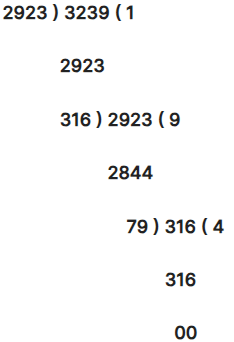Practice Questions: HCF and LCM Number | Quantitative Techniques for CLAT PDF Download
Q1: Find the HCF of 2923 and 3239.
Ans: 79
Q2: Find the LCM of 23 * 32 * 52 *7 ; 25 * 53 * 72 ; 22 * 33 * 53 * 11 and 34 * 7 * 113
Ans: 25 * 33 * 53 * 72 * 113
Select the prime numbers with the highest powers and multiply them.
Q3: The ratio of two numbers is 3:5, their HCF is 12. Find the numbers.
Ans: Two numbers ratio= 3:4 i.e., numbers ⇒ 3x and 4x
HCF = 12; as x is the highest common factor in the above numbers therefore x=12
Numbers ⇒ 3*12 =36 & 5*12 = 60
Q4: If the product of two co-prime numbers is 117, then find their LCM.
Ans: Concept of Co – prime and HCF i.e., HCF of two co-prime numbers is 1
LCM * HCF = Product of two numbers
LCM * 1 = 117 ; LCM = 117
Q5: The product of the LCM and HCF of two numbers is 48. Difference between the two numbers is 4. Find the greater number among them.
Ans: Let two numbers be a and b
Therefore, a*b = 48 ; a-b = 8
Solving above equations we get, a=12 and b=4
Q6: LCM and HCF of two numbers are 13 and 455 respectively. If one of the numbers lie between 75 and 125, then find that number.
Ans: Given: LCM = 455 ; HCF=13
Product of numbers = LCM * HCF
=13*455 = 5915
Let the numbers be 13a and 13b ; 13a*13b = 5915
a*b = 35
Co-prime with product 35 are (1,35) and (5,7)
So, the numbers can be (1*13, 35*13) and (5*13, 7*13)
But one of the numbers lie between 75 and 125 that would be 91 giving us a suitable pair i.e., (65, 91).
Q7: Six bells start toll together and tolls at regular intervals of 2,4,6,8,10 and 12 respectively. In 30 minutes how many times they would have tolled together.
Ans: LCM of 2,4,6,8,10 and 12 is 120
Bells toll together after every 120 seconds i.e., 2 minutes
In 30 minutes they will toll together for (30/2 + 1) times i.e., 16 times
Q8: Find the least number which when increased by 3 is divisible by each one 24, 32, 36 and 54
Ans: LCM (24,32,36,54) = 864
As the question demands divisibility after increment therefore answer would be LCM+3 i.e., 864+3 = 867
Q9: Find the greatest possible length which can be used to measure lengths 7m, 3m 85cm and 12m 95cm.
Ans: Given: Lengths = 700cm; 385cm ; 1295cm
HCF = 35cm (greatest possible length for measure = HCF)
Q10: If N is the greatest number dividing 1305, 4665 and 6905 leaving the same remainder in each case, then Find the sum of digits of N.
Ans: N= HCF of (4665-1305), (6905-1305) and (6905-4665)
HCF of 3360, 2240 and 5600
N= 1120
Sum of Digits of N= 1+1+2+0 = 4.
|
49 videos|155 docs|73 tests
|
















